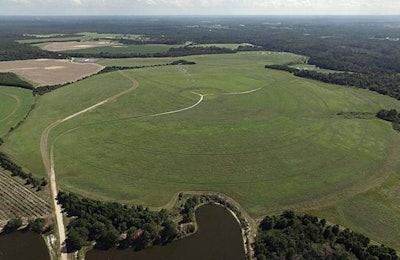
While Claxton Poultry Farms has always focused on environmental stewardship, almost 20 years ago its leadership made a conscious commitment to improve the performance of its poultry wastewater treatment through a renewed focus on water use and reuse operations. Claxton Poultry Farms has made good on its pledge with its efforts resulting in an honorable mention in the 2015 U.S Poultry and Egg Clean Water Award full treatment category. The Clean Water Award recognizes outstanding wastewater treatment facilities operated by poultry companies and allied industries.
Claxton Poultry processes 430,000 broilers per day using an average daily flow of 1.6 million gallons that is ultimately fully reclaimed by a land application system. More commonly seen full-treatment category honorees discharge into receiving streams with permit limitation comparable to a publicly owned treatment system. Those limitations include acute and chronic whole effluent toxicity testing related to aquatic life. However, unlike those full-treatment processors, monitoring requirements for Claxton Poultry include sampling nutrient levels in the spray field soils where the treated effluent is applied. Claxton Poultry thus really has an interest in its wastewater discharge long after it leaves the facility.
Tackling wastewater odor and reducing water usage
Conventional treatment processes are used in advance of land application including screening, chemically enhanced dissolved air flotation and aerated lagoons. These systems have been upgraded and complemented with an additional focus on enclosing unit processes for better odor and pest control.
A member and supporter of the Ogeechee-Canoochee Riverkeeper since its inception, Claxton Poultry Farms also benefited from the structure upgrades during an annual river race that had previously experienced residual odors that lingered in the lower, cooler adjacent river.
The facility has also focused on in-facility processing, such as enhanced blood capture to recover nitrogen from wastewater while increasing blood protein sold to rendering. And while recent in-facility initiatives have yielded a 28 percent reduction in per-bird water usage, the facility has really taken water reclamation to a next step.
Land application site showcases poultry stewardship
The showcase of the Claxton Poultry Farms commitment to environmental stewardship is the Riverside Farms land application site, a location that comprises 1,982 total acres. Pre-treated wastewater is pumped through a six-mile force main to a holding and equalization pond at the land application system. Here, 682 acres are currently permitted for up to 1.6 million gallons per day of wastewater application.
Recently, Claxton Poultry leased an additional 1,208 acres to expand the land application system to a total of 3,262 acres with 782 acres for wastewater application. The expanded site will allow an increased irrigation capacity to 2.0 million gallons per data with greater flexibility regarding system operations and storage management.

One of twelve center-pivot irrigation rigs. The pivot pictured covers 200 acres using a 1,992-foot system.
Steven Fries, Claxton Poultry Farms environmental manager, said, “Riverside Farms transforms our full treatment wastewater operation into a sustainable water reclamation system. We naturally filter our water with plants and soils, ultimately returning the water to its source. We know we are doing a good job since ground and surface water along with soil samples are collected by an independent company and analyzed by accredited laboratories to ensure we are meeting or exceeding our permit.”
Fries added, “At Riverside Farms we use two types of cover crops. Typically, Bermudagrass overseeded with winter rye and hay is harvested in a manner that allows operational flexibility. Because the conventional pretreatment system at the facility does so well at reducing nitrogen, we have some choices with our crop selections while still providing the maximum nitrogen uptakes possible.”
A recent permit modification has allowed for alternative crops as long as these are not used for human consumption. Thus, cotton is grown, as well as corn which is used for poultry feed, enabling less-frequent crop removal with better weed control and nitrogen uptake.
Reclaimed scrubland with poultry wastewater
Claxton Poultry Farms reclaimed poor pasture lands to develop its land application system, but by focusing on leadership’s commitment to environmental stewardship, it has created a setting that many, if not all, might imagine when they envision what an American farm should look like. The undeveloped, forested lands surrounding the land application system also provide food, cover, nesting or bedding refuge for the wildlife found around the farms, forests and river bottoms.
Riverside Farms also provides recreation for Claxton Poultry Farms employees and guests. Fries noted, “We fish, hunt and even target shoot out here. I even live nearby and enjoy flying drones out here.”
Not many other environmental managers can claim they are happy to raise their family adjacent at the most critical part of their full treatment system, but the beauty of Riverside Farms makes that easy to understand.

One of several fishing ponds located on Riverside Farms.
Learn more about Clean Water Award winners: www.wattagnet.com/articles/24726
















